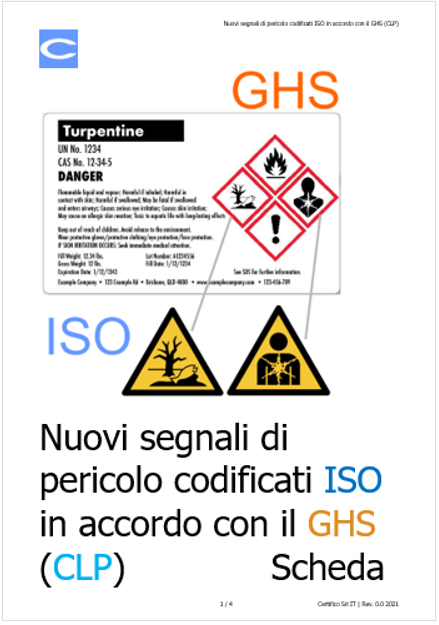I nuovi CER: da domani 1° Giugno

I nuovi CER: da domani 1° Giugno
Entra in vigore domani 1° Giugno il Nuovo Catalogo Europeo dei Rifiuti CER 2015
CER 2015
Decisione 2014/955/UE DECISIONE DELLA COMMISSIONE del 18 dicembre 2014 che mod...
Guideline No. 497 - 14 June 2021
A Defined Approach (DA) consists of a selection of information sources (e.g in silico predictions, in chemico, in vitro data) used in a specific combination, and resulting data are interpreted using a fixed data interpretation procedure (DIP) (e.g. a mathematical, rule-based model). DAs use methods in combination and are intended to overcome some limitations of the individual, stand-alone methods.
The first three DAs included in this Guideline use combinations of OECD validated in chemico and in vitro test data, in some cases along with in silico information, to come to a rules-based conclusion on potential dermal sensitisation hazard.
The DAs included in this Guideline have shown to either provide the same level of information or be more informative than the murine Local Lymph Node Assay (LLNA; OECD TG 429) for hazard identification (i.e. sensitiser versus non-sensitiser). In addition, two of the DAs provide information for sensitisation potency categorisation that is equivalent to the potency categorisation information provided by the LLNA.
______
Table of Contents
OECD GUIDELINE FOR TESTING OF CHEMICALS
1. Section 1-Introduction
General Introduction
DAs and Use Scenarios included in the Guideline
Limitations
1.3.1. Limitations of individual in chemico/in vitro information sources
1.3.2. Limitations of in silico information sources
1.3.3. Limitations of DAs
References
Part I. – Section 2 - Defined Approaches for Skin Sensitisation Hazard Identification
“2 out of 3” Defined Approach
2.1.1. Summary
2.1.2. Data interpretation procedure
2.1.3. Description and limitations of the individual information sources
2.1.4. Confidence in the 2o3 DA predictions
2.1.5. Predictive capacity of the 2o3 DA vs. the LLNA
2.1.6. Predictive capacity of the 2o3 DA vs. Human Data
2.1.7. Predictive capacity of the LLNA vs. Human Data
2.1.8. Proficiency chemicals
2.1.9. Reporting of the DA
References
Part II. –SECTION 3 - Defined Approaches for Skin Sensitisation Potency Categorisation
“Integrated Testing Strategy (ITS)” Defined Approach
3.1.1. Summary
3.1.2. Data interpretation procedure
3.1.3. Description and limitations of the individual information sources
3.1.4. Confidence in the ITS DA predictions
3.1.5. Predictive capacity of the ITSv1 DA vs the LLNA
3.1.6. Predictive capacity of the ITSv2 DA vs the LLNA
3.1.7. Predictive capacity of the ITSv1 DA vs Human Data
3.1.8. Predictive capacity of the ITSv2 DA vs Human Data
3.1.9. Predictive capacity of the LLNA vs. Human Data
3.1.10. Proficiency chemicals
3.1.11. Reporting of the DA
References
Annex 1: Prediction model for the individual in chemico/in vitro tests with multiple runs for use in 2o3 DA
Annex 2: Defining the applicability domain and assessing confidence in DASS ITS predictions and protocols for generating in silico predictions
Introduction
Applicability domain of the individual information sources
In chemico/in vitro information source (DPRA and h-CLAT)
In silico information source
Derek Nexus (ITSv1)
QSAR Toolbox (ITSv2)
Confidence in ITS predictions
How to apply the data interpretation procedure (DIP) for the ITS
References
Appendix 1: Protocol for Derek Nexus predictions
Protocol for generating predictions for skin sensitisation hazard using Derek Nexus v.6.1.0 with Derek KB 2020 1.0
Appendix 2: Protocol for OECD QSAR Toolbox predictions
Protocol for generating predictions for skin sensitisation hazard using DASS AW in Toolbox 4.5
Appendix 3: Information on applicability domain for OECD QSAR Toolbox
Technical aspects
Calculation of the in silico domain of Toolbox
Calculation of applicability domain layers
1. Parametric layer
2. Structural layer
3. Mechanistic layer
...
Fonte: OECD

Entra in vigore domani 1° Giugno il Nuovo Catalogo Europeo dei Rifiuti CER 2015
CER 2015
Decisione 2014/955/UE DECISIONE DELLA COMMISSIONE del 18 dicembre 2014 che mod...
COMUNICAZIONE DELLA COMMISSIONE AL CONSIGLIO, AL PARLAMENTO EUROPEO E AL COMITATO ECONOMICO E SOCIALE EUROPEO relativa all'attuaz...

ID 13307 | 12.04.2021 / Scheda allegata Abbonati Chemicals
ISO 7010:2019 Amd 2 Novembre 2020 Graphical symbols - Safety colo...
Testata editoriale iscritta al n. 22/2024 del registro periodici della cancelleria del Tribunale di Perugia in data 19.11.2024